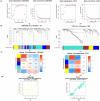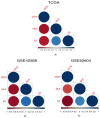In Silico Analysis of Ion Channels and Their Correlation with Epithelial to Mesenchymal Transition in Breast Cancer
- PMID: 35326596
- PMCID: PMC8946083
- DOI: 10.3390/cancers14061444
In Silico Analysis of Ion Channels and Their Correlation with Epithelial to Mesenchymal Transition in Breast Cancer
Abstract
Uncontrolled growth of breast cells due to altered gene expression is a key feature of breast cancer. Alterations in the expression of ion channels lead to variations in cellular activities, thus contributing to attributes of cancer hallmarks. Changes in the expression levels of ion channels were observed as a consequence of EMT. Additionally, ion channels were reported in the activation of EMT and maintenance of a mesenchymal phenotype. Here, to identify altered ion channels in breast cancer patients, differential gene expression and weighted gene co-expression network analyses were performed using transcriptomic data. Protein-protein interactions network analysis was carried out to determine the ion channels interacting with hub EMT-related genes in breast cancer. Thirty-two ion channels were found interacting with twenty-six hub EMT-related genes. The identified ion channels were further correlated with EMT scores, indicating mesenchymal phenotype. Further, the pathway map was generated to represent a snapshot of deregulated cellular processes by altered ion channels and EMT-related genes. Kaplan-Meier five-year survival analysis and Cox regressions indicated the expression of CACNA1B, ANO6, TRPV3, VDAC1 and VDAC2 to be potentially associated with poor survival. Deregulated ion channels correlate with EMT-related genes and have a crucial role in breast cancer-associated tumorigenesis. Most likely, they are potential candidates for the determination of prognosis in patients with breast cancer.
Keywords: RNA-Seq; bioinformatics; interaction networks; membrane proteins; microarray; prognosis.
Conflict of interest statement
The authors declare no conflict of interest.
Figures








Similar articles
-
Aberrations in ion channels interacting with lipid metabolism and epithelial-mesenchymal transition in esophageal squamous cell carcinoma.Front Mol Biosci. 2023 Jul 17;10:1201459. doi: 10.3389/fmolb.2023.1201459. eCollection 2023. Front Mol Biosci. 2023. PMID: 37529379 Free PMC article.
-
Identification of epithelial-mesenchymal transition-related circRNA-miRNA-mRNA ceRNA regulatory network in breast cancer.Pathol Res Pract. 2020 Sep;216(9):153088. doi: 10.1016/j.prp.2020.153088. Epub 2020 Jun 29. Pathol Res Pract. 2020. PMID: 32825956
-
Identification of hub genes associated with EMT-induced chemoresistance in breast cancer using integrated bioinformatics analysis.Gene. 2022 Jan 30;809:146016. doi: 10.1016/j.gene.2021.146016. Epub 2021 Oct 13. Gene. 2022. PMID: 34655723
-
Plasma membrane ion channels and epithelial to mesenchymal transition in cancer cells.Endocr Relat Cancer. 2016 Nov;23(11):R517-R525. doi: 10.1530/ERC-16-0334. Epub 2016 Sep 12. Endocr Relat Cancer. 2016. PMID: 27619258 Review.
-
Transient Receptor Potential Channels in the Epithelial-to-Mesenchymal Transition.Int J Mol Sci. 2021 Jul 30;22(15):8188. doi: 10.3390/ijms22158188. Int J Mol Sci. 2021. PMID: 34360952 Free PMC article. Review.
Cited by
-
ANO6 Targets TMEM30A to Regulate Endoplasmic Reticulum Stress-Induced Lipid Peroxidation and Ferroptosis in Alzheimer's Cells.Cell Biochem Biophys. 2025 Apr 13. doi: 10.1007/s12013-025-01748-9. Online ahead of print. Cell Biochem Biophys. 2025. PMID: 40221538
-
A Proteogenomic Approach for the Identification of Virulence Factors in Leishmania Parasites.Methods Mol Biol. 2025;2859:279-296. doi: 10.1007/978-1-0716-4152-1_16. Methods Mol Biol. 2025. PMID: 39436608
-
Establishment and Analysis of an Individualized EMT-Related Gene Signature for the Prognosis of Breast Cancer in Female Patients.Dis Markers. 2022 Jul 28;2022:1289445. doi: 10.1155/2022/1289445. eCollection 2022. Dis Markers. 2022. PMID: 35937944 Free PMC article.
-
A bioinformatics analysis: ZFHX4 is associated with metastasis and poor survival in ovarian cancer.J Ovarian Res. 2022 Aug 1;15(1):90. doi: 10.1186/s13048-022-01024-x. J Ovarian Res. 2022. PMID: 35915456 Free PMC article.
-
Chloride Intracellular Channel Proteins (CLICs) and Malignant Tumor Progression: A Focus on the Preventive Role of CLIC2 in Invasion and Metastasis.Cancers (Basel). 2022 Oct 6;14(19):4890. doi: 10.3390/cancers14194890. Cancers (Basel). 2022. PMID: 36230813 Free PMC article. Review.
References
-
- Scully O.J., Bay B.H., Yip G., Yu Y. Breast cancer metastasis. Cancer Genom. Proteom. 2012;9:311–320. - PubMed
-
- Sharma J., Deb B., George I.A., Kapil S., Coral K., Kakkar N., Pattanaik S., Mandal A.K., Mavuduru R.S., Kumar P. Somatic Mutations Profile of a Young Patient With Metastatic Urothelial Carcinoma Reveals Mutations in Genes Involved in Ion Channels. Front. Oncol. 2019;9:435. doi: 10.3389/fonc.2019.00435. - DOI - PMC - PubMed
-
- Han Y., Liu C., Zhang D., Men H., Huo L., Geng Q., Wang S., Gao Y., Zhang W., Zhang Y., et al. Mechanosensitive ion channel Piezo1 promotes prostate cancer development through the activation of the Akt/mTOR pathway and acceleration of cell cycle. Int. J. Oncol. 2019;55:629–644. doi: 10.3892/ijo.2019.4839. - DOI - PMC - PubMed
LinkOut - more resources
Full Text Sources

